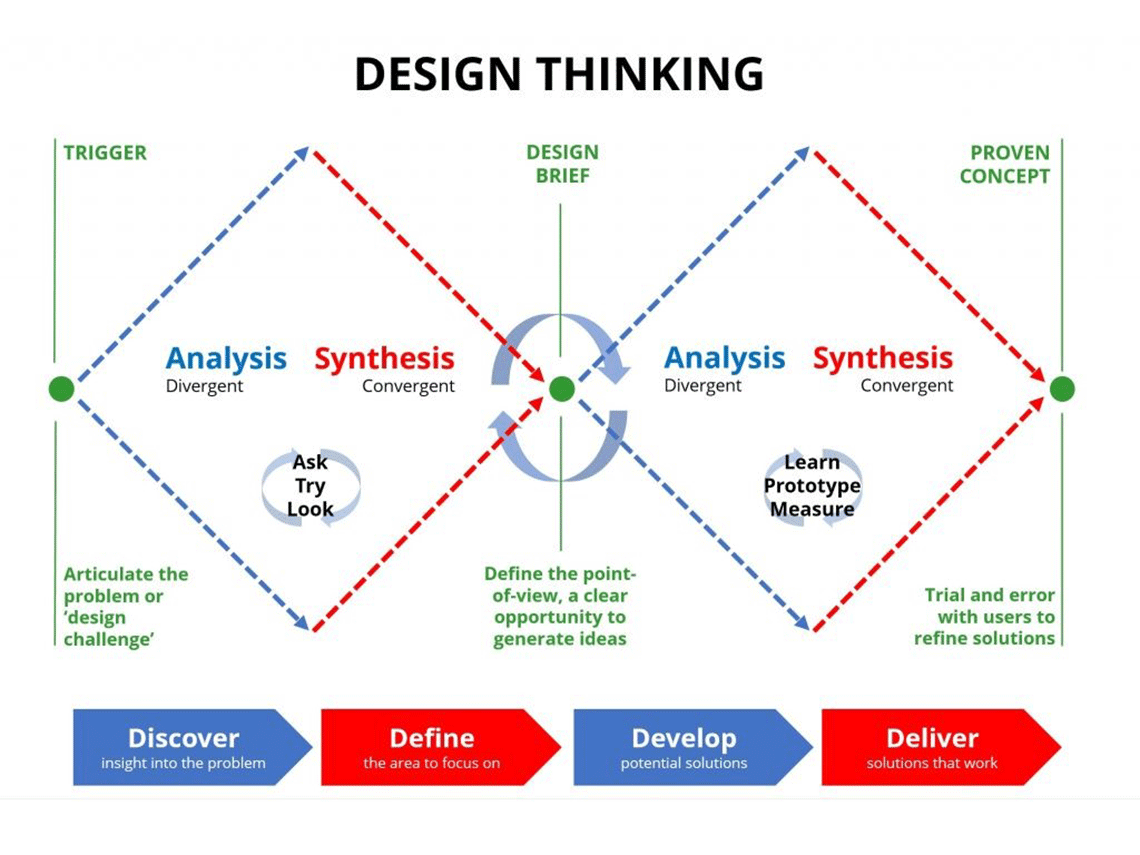Getting to grips with Design Thinking

As companies strive to keep up with innovation, Design Thinking can’t be missed.
Andy Eklund is a facilitator at the Australian Institute of Management. He’s spent 35,000 hours facilitating 6,500 workshops for 11,000 participants in 24 countries on 5 continents. That’s ore 700 different clients in 75 different industries.
Here, Andy shares his knowledge on the Design Thinking process.
Given that Design Thinking is still relatively new, there isn’t one universal process. There are several good models created by universities and academics, and several great ones invented by consultancies (some of which are aligned with universities).
While I may use other models in practical application, I decided on the version below because it also aligns to other key elements of creativity, such as 1) divergent vs. convergent, and 2) analysis vs. synthesis.
The four stages of Design Thinking are Discover, Define, Develop and Deliver.

My design, adapted from the Double Diamond Design Process, UK Design Council, 2005
1. Discover
The process begins with a trigger: a problem, opportunity, observation, a change in the market place, among many others. Whereas the Old Model of Business would immediately develop a plan to fix the symptom (not necessarily the problem itself), the team in the Discover stage takes a step back to look holistically and with a fresh eye at the ‘mystery‘ to determine where the business is now, understand the current situation, and decide what area(s) to pursue. It begins with Empathy to seek information from a particular audience and to interpret their behaviour and values without bias. This observation is done in their natural environment (as opposed to an artificial environment like a focus group). The mindset should be focused on divergent (expanding information to seek many answers) and on analysis (breaking down the whole into parts).
In addition to searching for the what we (may) know about the mystery, some businesses/designers may begin to consider the:
- Why – the intent, objective or a rough statement which eventually will become the design challenge or point-of-view,
- Who – the potential team necessary to move the process forward,
- How – the criteria will be used to judge a successful outcome,
- Where – the creative space that the team will need to develop the campaign,
- When – the potential time frame for the program.
Be careful! Setting the intent too narrowly at the beginning may limit the creative potential later on. That said, the next phases should correct this narrowness if the lead designer and his/her team keeps an open mind.
2. Define
The second stage of the process comes from a place of growing understanding, where the team – flush with information – attempts to extract insights. In other words, What does all this mean? What matters most? What should be our priority? What may be feasible? The goal of this stage is to formalise the brief (the design challenge, its point of view, the audience, the strategy) so a business plan can be created soon. (‘Soon’ is the operative word as all these elements will continue to change as the team synthesises the information.) The mindset should be focused on convergent (reducing information down to a single answer) and on synthesis (combining individual parts to create a whole).
In an ideal world, the insights and themes come out naturally, but it’s more likely that the team will return to the beginning, to learn more, seek validation, check vagueness. That’s what iterative processes are – repeating key steps as needed to extract solutions, sometimes in tandem with other steps (as opposed to linear processes which doesn’t allow a user to move to the next step until the previous one is finished). Most important, that’s OK … and a natural part of Design Thinking.
3. Develop
The third stage begins with a burst of creativity and imagination. Because the design brief outlines the clear opportunity, the team begins creating solutions and concepts. Inside the creative space, the goal is volume of ideas. The details and specifications are irrelevant at this stage. It’s not just throwing out ideas, it’s physically making the ideas. This forces the team to think visually (as a designer), because by using your hands you have a better sense intuitively if your ideas is right or wrong, and how to improve it. Oftentimes you work directly with the end user to create and build the ideas. Returning to a period of divergency and analysis, the team builds rough prototypes (also known as low-res or low-fidelity), seeks feedback from users, and continues to refine the ideas into clear options.
By this stage, businesses are often impatient. The Old School mindset sees CHAOS and MESS when it wants answers. That’s why it’s critical that senior management is actively involved with this section – and another reason why visualisation is vital. The more that people can see, experience the prototypes, and hear directly from users allows everyone on the team to feel that they’re going in the right direction.
4. Deliver
The fourth quarter moves from exploration to engineering. In this phase, it’s important to keep a mindset of “fail early, fix quickly.” Prototypes are moved to test phase, some may even be launched as a pilot or offered for a limited time to test their impact in the marketplace so feedback can be sought and the business’ understanding deepens. In turn, this realisation influences the business plan and strategy.
Want to delve into the world of Design Thinking? Why not enrol in AIM’s one-day, on-campus Design Thinking: Transform how you Create and Innovate course?
